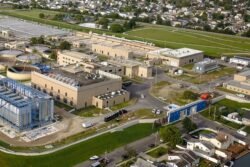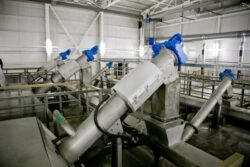MBR Wastewater Treatment Plant: An In-Depth Analysis of Technological Advancements and Environmental Impact
Introduction
In the quest for sustainable water management, Membrane Bioreactor (MBR) technology has emerged as a pivotal solution for wastewater treatment. As urbanization continues to escalate and water scarcity issues loom large globally, advanced wastewater treatment methods like MBR are not just innovations; they are necessities. With the ability to produce high-quality effluent suitable for various re-use applications, MBR systems are transforming the wastewater landscape. This article aims to provide an in-depth analysis of MBR technology, addressing its importance, applications, operational challenges, and future developments.
Understanding MBR Technology
Definition and Mechanism
Membrane Bioreactors (MBRs) are hybrid systems that integrate biological treatment processes with membrane filtration. In these systems, activated sludge reactors are used in tandem with microfiltration (MF) or ultrafiltration (UF) membranes, effectively separating solid residues from treated water. According to a recent report by the Water Environment Federation (WEF), MBR technology can reduce the required footprint for wastewater treatment facilities by up to 75% compared to conventional processes.
Key Components of an MBR System:
- Bioreactor: Provides an aerobic or anaerobic environment where microorganisms degrade organic pollutants.
- Membrane Module: Acts as a barrier, filtering out suspended solids and pathogens while allowing clean water to pass through.
- Permeate Pump: Facilitates the movement of filtered water from the membrane module to further treatment or direct discharge.
- Sludge Management System: Handles the excess biomass generated during the treatment process.
Types of MBR Configurations
- Submerged MBR: Here, membranes are submerged directly within the bioreactor tank. This configuration is common in municipal wastewater applications.
- External MBR: In this setup, membranes are located outside the bioreactor. This allows for easier maintenance but requires additional pumping energy.
Advantages of MBR Technology
High Effluent Quality
MBR systems are distinguished by their ability to produce effluent that meets or surpasses stringent discharge standards. Recent studies indicate that MBR-treated water can reach a Total Suspended Solids (TSS) level below 1 mg/L and a Biological Oxygen Demand (BOD) of 2 mg/L, making it suitable for various reuses, including irrigation, industrial processes, and even potable water in some advanced systems.
Space Efficiency
One of the most compelling advantages of MBR technology is its compact footprint. According to the European Commission, MBR plants require approximately 30-50% less space than traditional activated sludge plants. This efficiency is crucial in densely populated urban areas where land is at a premium.
Energy Efficiency and Lower Operational Costs
While energy consumption has been a concern in MBR systems due to membrane fouling, recent advancements in membrane technology and aeration processes have significantly reduced energy requirements. Research published in Environmental Science & Technology found that new membrane materials can lower energy consumption by up to 25% without compromising performance.
Reduced Sludge Production
The MBR process often results in less biomass production compared to conventional methods. This reduction in sludge volume lessens the burden of sludge management, lowering disposal costs and minimizing environmental impact.
Addressing Pain Points in MBR Implementation
Membrane Fouling
One of the primary challenges facing MBR technology is membrane fouling, which can lead to reduced permeability and increased operational costs. Strategies to mitigate this issue include:
- Regular Cleaning: Implementing a cleaning regime that includes backwashing and chemical cleaning can help maintain membrane performance.
- Optimized Aeration: Adjusting aeration rates can help reduce fouling by minimizing the accumulation of organic matter on the membrane surface.
- Pre-treatment Solutions: Utilizing pre-treatment technologies such as coagulation-flocculation or ozonation can reduce foulants entering the MBR.
Capital and Operational Costs
The initial cost of installing MBR systems can be higher than conventional treatment methods, which can be a significant drawback for municipalities. However, ongoing cost efficiencies in operational savings due to reduced space and maintenance needs often justify the initial investment. A 2020 analysis from the American Society of Civil Engineers (ASCE) suggests that the life-cycle costs of MBR systems can be lower than traditional treatment approaches, especially in water-scarce regions.
Applications of MBR Technology
Municipal Wastewater Treatment
Municipalities around the world have adopted MBR systems to handle growing wastewater volumes. For instance, the L’Isle-d’Abeau MBR plant in France employs this technology to treat 20,000 m³/day, meeting stringent EU discharge regulations.
Industrial Applications
Industries such as pharmaceuticals, food and beverage, and petrochemicals have found MBR systems adept at managing complex wastewater streams that contain high levels of biochemical oxygen demand (BOD) and chemical oxygen demand (COD). Case studies reveal that industrial MBR implementations can achieve over 99% removal rates for pollutants, significantly enhancing compliance with environmental standards.
Water Reuse
As demand for recycled water intensifies due to drought and population growth, MBR systems are increasingly being deployed for treated wastewater reclamation. In Singapore, the NEWater project exemplifies successful large-scale application where MBR technology is essential to ensuring water supply sustainability.
Future Perspectives for MBR Technology
Research and Development
Ongoing research into advanced membrane materials, such as graphene-based membranes, promises to further improve the energy efficiency and lifespan of MBR systems. Industry experts predict that next-generation membranes could cut fouling rates by 50% or more.
Policy and Regulatory Frameworks
As governments and agencies recognize the importance of water quality and conservation, supportive policies are likely to accelerate MBR adoption. Improved regulatory measures around water reuse are particularly expected to create a favorable environment for MBR technologies.
Conclusion
In conclusion, MBR technology represents a transformative leap in wastewater treatment, offering a range of benefits from high effluent quality to compact system designs. As urbanization and climate challenges push water scarcity to the forefront, MBR systems are poised to play a critical role in sustainable water resource management. By addressing current pain points, such as membrane fouling and initial investment costs, stakeholders can maximize the potential of MBR technology for the future. Moving forward, continued innovation and supportive policies will be essential to fully realize the benefits of MBR systems and to contribute to a sustainable environmental footprint.
In summary, MBR wastewater treatment plants are not merely a technical solution; they are an essential component of a broader strategy for modern water management. As water security becomes increasingly critical, the importance of such advancements cannot be overstated.
This comprehensive analysis aims to serve as an authoritative resource for wastewater treatment professionals, facility managers, and stakeholders exploring MBR technologies. By addressing common concerns and highlighting key applications, the article integrates valuable insights that underscore the crucial role of MBR systems in a sustainable water future.
source https://www.waterandwastewater.com/mbr-wastewater-treatment-plant/



No comments:
Post a Comment